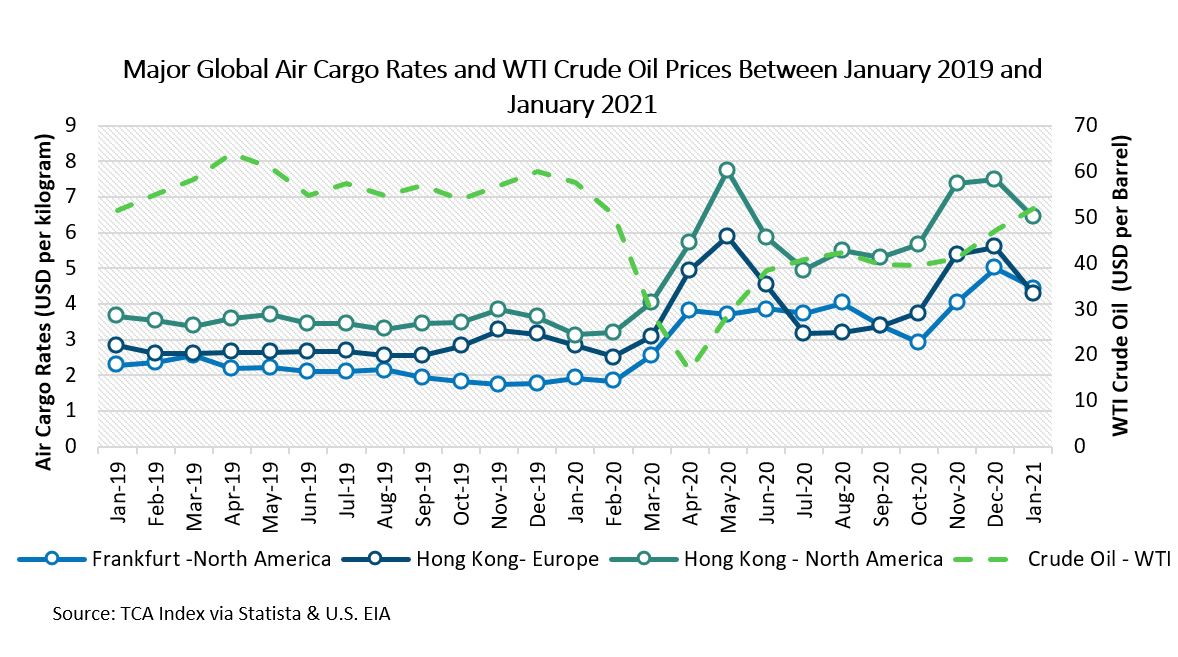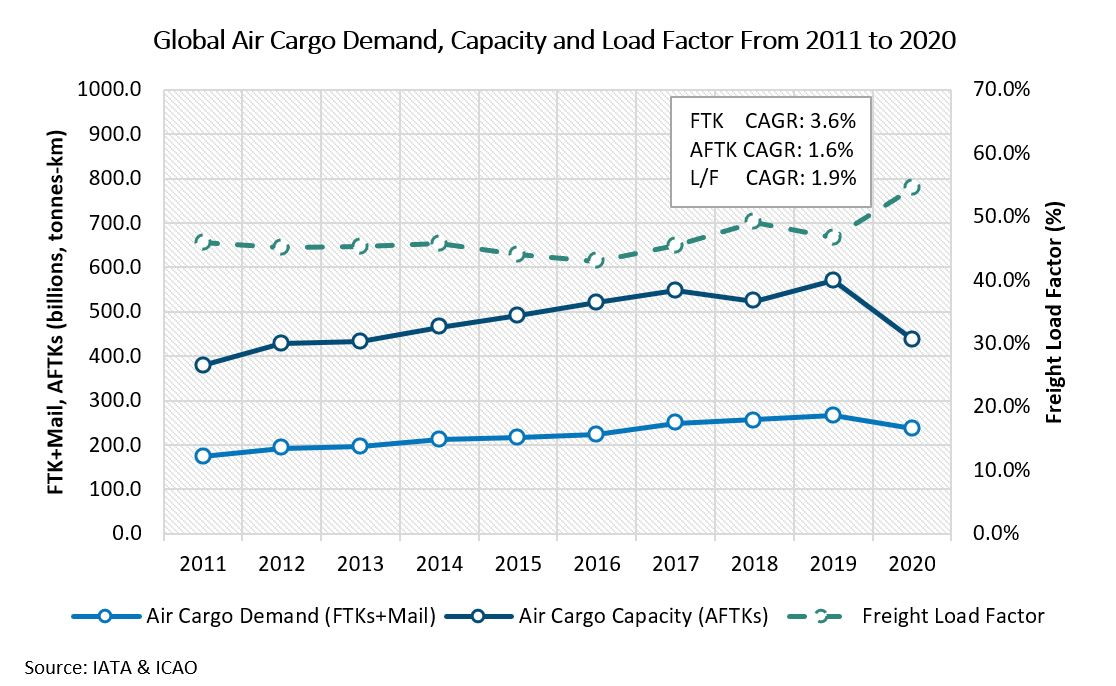18/06/2021
As well the vital role it continues to play in supporting the global economy, the air cargo market is now becoming increasingly important in powering global COVID vaccine distribution.
Whilst around 3% of global trade volume is carried by air, it is estimated that 35% of the global trade value is transported using air cargo supply chains. Using data from IBA's InsightIQ, IATA, ICAO and Boeing, we have explored drivers of demand in the global air cargo market on a macro level, and highlighted 4 of the key drivers of demand.
E-Commerce accounts for approximately 15.5% of the retail market and has steadily increased as a percentage of total retail sales in recent years. The seemingly endless boom in online shopping habits have been a key driver in this surge in cross-border e-commerce.
International e-commerce was valued at $4.8 trillion USD in 2020.
Cross-border e-commerce now accounts for 35% of the market, and is forecasted to be valued at $1 trillion USD by 2022.
80% of total cross-border volumes are transported by air.
This has also manifested itself in online retail giants implementing their own airborne logistic units, such as Amazon Prime Air and Alibaba Logistics.
Another driver of growth in the air cargo market is the transport of time-sensitive and high-value cargo, typically medical equipment, perishable goods, and medicines. As the 2020 global PPE shortage took hold, a number of primarily passenger airlines started to operate cargo-only flights, allowing them to return a portion of their parked aircraft to service and make up for lost revenue. Prominent examples included Virgin Atlantic, British Airways, and Finnair. Some mixed passenger and cargo airlines, such as Emirates and Icelandair, temporarily converted passenger aircraft into freighters to meet the surge in demand.
As most of the passenger fleet remained grounded throughout 2020, air cargo rates continued to be inflated above average, and industry sentiment indicates that rates will continue along this path in the short term. We note however that historically, freighter rates have been low, in the region of USD 2-5 per kg transported, and the profitability of dedicated freighter operators has been low.
As most of the passenger fleet remained grounded throughout 2020, air cargo rates continued to be inflated above average. Industry sentiment indicated that this trend will continue in the short-term. It is important to note that, historically, freighter rates have been low (in the region of $2-5USD per kg transported) and the profitability of dedicated freighter operators has been low.
Despite the decrease in crude oil prices, air cargo rates increased independently from crude oil in March 2020, consistent with the increase in demand and decrease in capacity.
After July 2020, as the air cargo capacity started to trend up and crude oil prices returned to the 10-year mean of USD 69 per barrel, air cargo rates appear to have started to decrease. The chart below shows global air cargo rates against WTI crude oil prices between Jan 2019 and Jan 2021. The highest rate observed was on the Hong Kong to North America routes with an average price of $3.84 USD per kg in Nov 2019. Hong Kong to North America saw the highest increase in rates as a result of travel restrictions and falling currency. As of early 2021, air cargo rates have declined slightly while crude oil continued to trend upward.

GDP and merchandise trade volume continue to have an impact on air cargo demand.
After global GDP contraction in 2020, the IMF projected global GDP to grow by 5.2% YoY in 2021, with air cargo demand remaining strong.
In 2020, air cargo demand contracted at twice the rate of GDP.
World merchandise trade volume is a measure of total merchandise trade, including inward and outward movement of goods through a country.
In 2020, world merchandise volume traded decreased by 5.3% YoY, compared to an increase of 0.2% YoY in 2019.
World trade volume reached its all-time high of 4.3% YoY growth in in 2017, but has been in decline since.
The loss in the momentum of growth volume after 2017 is partially due to increased trade tensions and restrictions (such as those between the USA and China). World trade volumes are expected to rebound by 8% YoY in 2021, but are expected to remain below pre-pandemic levels.
According to IATA, approximately half of global air cargo carried is transported as belly cargo on passenger aircraft. Historically, cargo-only airlines like FedEx and Cargolux did not see a growth in their revenue proportional to the overall increase in capacity in the market. This is likely due to passenger airlines increasing their belly cargo capacity or operating a small fleet of dedicated freighters. In 2020, this trend reversed as passenger airlines parked their fleet and the overall capacity was negatively affected. In return, it added more pressure on cargo airlines to cover for lost capacity which saw them bringing back parked aircraft into service and thus revenue was up in 2020. This highlights an inverse relationship between capacity and cargo revenues.
The air cargo load factor increased to a near all-time high of 54.5% in 2020, according to data from IATA.
Higher load factors are being driven by global freight capacity decreasing by 23% YoY to 437 billion tonne-kilometres (coupled with slower demand)
According to estimates from Boeing, slower growth rates are expected in mature trade markets within and between Europe and North America over the next decade. The Asia Pacific region is predicted to continue to lead the growth, with the Chinese domestic market projected to grow faster than the global average.

IBA expects a recovery in air cargo capacity, reflected in the decrease in air cargo rates. In what appears to be a recovery period for the air cargo industry in early 2021, the increase in capacity appears to be much slower than the demand, and therefore rates and load factors are expected to remain high in the short term. The latest wave of COVID restrictions in Europe and across other regions could potentially affect the market's speed of recovery in 2021 as capacity is restricted. A return to pre-pandemic capacity is not feasible in the short term.

IBA's InsightIQ analysis platform flexibly illustrates multiple asset, fleet and market positions, actual and potential, to inform client choices and identify acquisition opportunities. Immediate access to crucial aircraft, engine, lease rate and fleet data eases appreciation of historic and future aircraft concentrations and operator profiles.
Related content